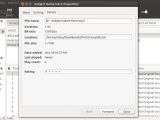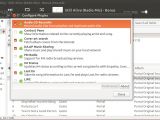Rhythmbox is an integrated music management application, designed to work under the Gnome desktop environment and based on GStreamer. It makes no excuses for trying to resemble Apple’s iTunes and has been the default music player in Ubuntu operating systems since the release of 12.04 LTS.
Rhythmbox has been introduced into Ubuntu 12.04 for the first time to replaced Banshee, a somewhat similar software. It’s deeply embedded into the system, but very few people know that it can do some interesting stuff, besides playing music.
The application is quite old and it was initially released in 2001, more than 11 years ago. It’s been growing steadily over the years to become one of the top choices for OS builders.
Installation
This is the part where we would usually explain how to install the software in question, but the developer from the GNOme team doesn’t provide any packages, except the source.
[admark=1]The installation of a complex application such as Rhythmbox is laborious and it can take a lot of time, especially if the user doesn’t have the necessary dependencies in the system.
In any case, if you choose to download and install this software, just follow the normal steps, in a terminal. More details about the procedure, if you’ll encounter any problems, can be found in the INSTALL file.
./configure make make install
We tested the Rhythmbox package in Ubuntu 12.10 (Quantal Quetzal), which is at version 2.97, just a tad older than the newly launched 2.98. In any case, it proved to be a stable version.
Usage
The program can be easily started from Unity or from the Sound placeholder in the upper right part of the desktop.
The interface is clear and can be understood by anyone, but it will require a little effort from the users, if they are not well versed with the iTunes way of doing things.
We are all familiar with music players and over the years, most applications have adopted a clear recipe, either on Linux or on Windows.
Rhythmbox is trying to resemble iTunes, so the interface and the way it’s organized are a little different from the norm.
The import function is still there, if the user chooses to get his own music into the program. It’s no longer just a huge playlist managed with playback controls. The interface contains a lot more information and services.
First of all, the Library entry in the left side of the Rhythmbox features pretty much all of the player’s capabilities. Besides the obvious Play Queue entry, there’s Music which lists the local tracks, Podcast, Last.fm, Libre.fm, and Radio.
The main window also has an entry for Ubuntu One, allowing users to buy music straight from the interface, with little to no effort.
Three predefined playlists are also present, making the navigation through the imported music simpler. Users can also create custom playlists and save them on the hard drive.
Rhythmbox can provide a lot of other functions and its strength lies in plugins. The software is capable of recording audio CDs from playlists, finding cover art for the songs in the library, interfacing with Apple iPod devices, and a lot more.
The Bad
The cumbersome playlist filters don’t feel natural in managing large libraries, especially after we used other standards for quite some time.
Another major problem is the lack of binary files from the developer. It’s understandable, especially because Rhythmbox is an important part of the GNOME desktop environment.
In Ubuntu, for example, it’s quite a hassle to update the application, without having to add the latest PPA from GNOME. It would have been nice to have a simple .deb file.
The Good
It is not the prettiest application and we stated in an earlier review that Clementine is by far a better alternative, but Rhythmbox has seniority on its side. It does what it is supposed to and it has developers who dedicate a lot of their time to constantly improve it.
Conclusion
It’s a music management software that works without any major input from the user and that tries to give a sense of familiarity to people who have just migrated to a new operating system. As far as we can tell, it’s here to stay so you better get used to it.
 14 DAY TRIAL //
14 DAY TRIAL // 








